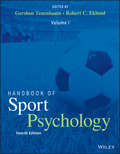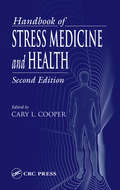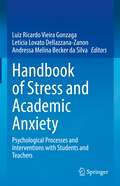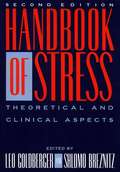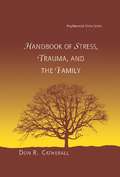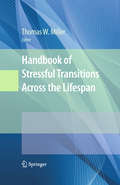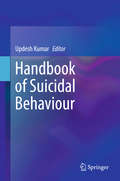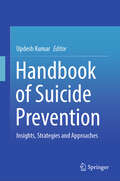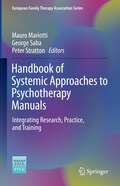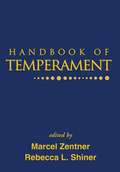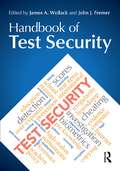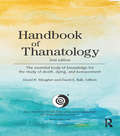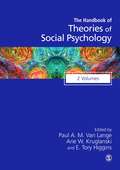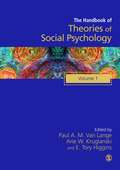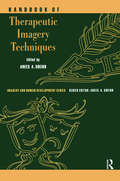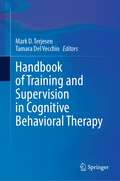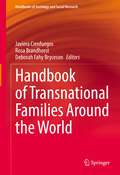- Table View
- List View
Handbook of Sport Psychology
by Gershon Tenenbaum Robert C. EklundThe fourth edition of a classic, leading resource for the field of sport, exercise, and performance psychology Now expanded to two volumes, and featuring a wealth of new chapters from highly respected scholars in the field, this all-new edition of the Handbook of Sports Psychology draws on an international roster of experts and scholars in the field who have assembled state-of-the-art knowledge into this thorough, well-rounded, and accessible volume. Endorsed by the International Society of Sport Psychology, it represents an invaluable source of theoretical and practical information on our understanding of the role of psychology in sport, exercise, and performance—and how that understanding can be applied in order to improve real-world outcomes. Presented in eight parts, the Handbook of Sports Psychology, 4th Edition adds new material on emerging areas such as mindfulness, brain mapping, self-consciousness, and mental toughness, and covers special topics such as gender and cultural diversity, athletes with disabilities, and alcohol and drug use in sports. In addition, it covers classic topics such as what motivates an athlete to perform; why do some choke under pressure; how do top performers handle leadership roles; what does one do to mentally train; how an athlete deals with injury; and much more. Fourth edition of the most influential reference work for the field of sport psychology New coverage includes mindfulness in sport and exercise psychology, ethics, mental toughness, sport socialization, and making use of brain technologies in practice Endorsed by the International Society of Sport Psychology (ISSP) Handbook of Sports Psychology, 4th Edition is an indispensable resource for any student or professional interested in the field of sports psychology.
Handbook of Strategies and Strategic Processing (Educational Psychology Handbook)
by Daniel L. Dinsmore Luke K. Fryer Meghan M. ParkinsonHandbook of Strategies and Strategic Processing provides a state-of-the-art synthesis of conceptual, measurement, and analytical issues regarding learning strategies and strategic processing. Contributions by educational psychology experts present the clearest-yet definition of this essential and quickly evolving component of numerous theoretical frameworks that operate across academic domains. This volume addresses the most current research and theory on the nature of strategies and performance, mechanisms for unearthing individuals’ strategic behaviors, and both long-established and emerging techniques for data analysis and interpretation.
Handbook of Strategies and Strategic Processing (Educational Psychology Handbook)
by Daniel L. Dinsmore Luke K. Fryer Meghan M. ParkinsonHandbook of Strategies and Strategic Processing provides a state-of-the-art synthesis of conceptual, measurement, and analytical issues regarding learning strategies and strategic processing. Contributions by educational psychology experts present the clearest-yet definition of this essential and quickly evolving component of numerous theoretical frameworks that operate across academic domains. This volume addresses the most current research and theory on the nature of strategies and performance, mechanisms for unearthing individuals’ strategic behaviors, and both long-established and emerging techniques for data analysis and interpretation.
Handbook of Strengths-Based Clinical Practices: Finding Common Factors
by Andy Young Jeffrey K. Edwards Holly J. NikelsAn interdisciplinary handbook about strengths-based clinical practices, this book finds the common factors in specific models from social work, psychology, and counseling. The book ends with a grounded theory informed method that pulls together what each of the chapters report, and posits a theory based on that work. Comprised of 23 chapters and written by leaders in the human services fields, Handbook of Strengths-Based Clinical Practices shows how professionals and students can facilitate change and resiliency in those with whom they work.
Handbook of Stress Medicine and Health
by Athel Cornish-BowdenResearch now shows us that long-term activation of the stress cycle can have a hazardous, even lethal, effect on the body, increasing the risk of obesity, heart disease, depression, cancer, and other illnesses. This new edition of an award-winning book presents cutting-edge research on the effects of stress.Edited by one of the worlds authorit
Handbook of Stress and Academic Anxiety: Psychological Processes and Interventions with Students and Teachers
by Luiz Ricardo Vieira Gonzaga Letícia Lovato Dellazzana-Zanon Andressa Melina Becker da SilvaThis handbook presents an overview of research on test anxiety and related forms of students’ stress and anxiety at schools and other academic environments, and also brings together a series of psychological interventions to prevent and treat anxiety disorders related to academic assessments. Its aim is to inform about strategies that help promote more adaptive behaviors towards academic assessment, as well as discuss other variables (e.g., bullying) that influence test anxiety, a typical stressor at the school and academic environment. These stressors can impair the students’ socio-cognitive development, impairing their ability to study and posing a risk to their mental health. The volume is organized in three parts. The first part brings together chapters discussing different variables and processes associated with academic anxiety, such as test anxiety and social influence, academic motivation, bullying, and procrastination. The second part is completely dedicated to psychological interventions with students designed to promote adaptive coping strategies to deal with academic anxiety and to prevent the development of psychopathologies associated with it. These interventions are based on different approaches, such as cognitive behavioral therapy, acceptance and commitment therapy, analytic behavioral therapy, dialectical behavioral therapy, and mindfulness, among others. Finally, the third part presents strategies that teachers can adopt to manage academic anxiety. The Handbook of Stress and Academic Anxiety: Psychological Processes and Interventions with Students and Teachers will be a valuable resource for school and clinical psychologists, teachers, school managers and policy makers by providing information based on the best scientific evidences to help students cope with academic anxiety, prevent the development of psychopathologies associated with it and promote mental health at schools and other academic environments.
Handbook of Stress, 2nd Ed
by Leo Goldberger Shlomo Breznitz40 essays by specialists examine a variety of stress-related conditions. They cover the clinical, research and theoretical aspects of stress - the concept of stress, biological/psychological phenomena, treatment and support. New to this edition are chapters on AIDS, the burnout phenomenon, ageing, chronic illness, the aftermath of the Holocaust, psychosomatic disorders, biomedical indices of stress and sexual abuse. The chapters on personality, emotion, cognitive processes, depression, bereavement, work-stress, disaster, trauma, alcoholism, stress management and social suppport have been significantly revised.
Handbook of Stress, Coping, and Health: Implications for Nursing Research, Theory, and Practice (2nd Edition)
by Virginia H. RiceThis unique and comprehensive handbook examines the various models of stress, coping, and health and their relevance for nursing and related health fields. Building on the first edition that has been highly-praised for its analysis and critique of existing models and its discussion of new research surrounding self-regulation and stress, this Second Edition continues to provide a critical analysis of the field while providing up to date cutting-edge research. Under the expert editorship of Dr. Virginia Hill Rice, experienced scholars and practitioners present a broad range of issues and research that relate to stress and health, such as response-oriented stress; stimulus-oriented stress; and transactional stress, coping, and health in children, adolescents, attitudes, and much, much more.
Handbook of Stress, Trauma, and the Family (Psychosocial Stress Series)
by Don R. CatherallThe Handbook of Stress, Trauma, and the Family is broken down into three sections, compiling research, theory and practice. The first section focuses on how traumatic stress affects intimate others, what familial characteristics affect individual susceptibility to trauma, as well as evaluation of the effectiveness of various interventions. The section on theory explores concepts of stress and intrapsychic processes underlying the intergenerational transmission of trauma, addressesing how families can buffer or enhance anxiety. The final section, entitled practice, covers assessment (presenting both the Circumplex Model and Bowenian family theory models), treatment models and treatment formats for specific populations. The major family treatment models applicable to stress and trauma are discussed, including contextual, object relations, emotionally focused and critical interaction therapy.
Handbook of Stressful Transitions Across the Lifespan
by Thomas W. MillerThe modern life cycle is characterized by stressful transitions, when unexpected events--and even many expected ones--challenge people's functioning, health, and sense of self-worth. The international, multidisciplinary perspectives provided in the Handbook of Stressful Transitions Across the Lifespan cover these periods as they occur through youth, adulthood, and aging, bringing together theoretical and clinical findings, case studies, and literature reviews in one authoritative volume. A diverse panel of clinicians, researchers, and educators focuses on the psychological, biological, cultural and spiritual factors surrounding not only trauma and loss but also coping and growth, risk and mitigating factors, and promising interventions. Whether topics are just beginning to receive in-depth attention (the first job; becoming adoptive parents), ongoing issues requiring new insights (veterans' adjustment to civilian life; chronic illness), or emerging concepts (trauma growth; animal-assisted therapy), coverage is well-written, engaging, and eminently useful. A sampling of the topics featured in the Handbook: The developmental neurobiology of stress. The long-term effects of divorce on children. Self-regulation across life transitions. Money in (E)motion: stressful financial transitions. The influence of food on adapting to life stressors. The transition to retirement as a stressful event. With its comprehensive scope and wealth of data, the Handbook of Stressful Transitions Across the Lifespan will appeal to a variety of professional readers, including researchers and scholars in the fields of social, developmental and clinical psychology, sociology, and public health.
Handbook of Suicidal Behaviour
by Updesh KumarThis essential reference volume in the field of suicidology brings forth leading-edge conceptualizations of suicidal behaviour by including emerging trends and recent research advances in the field across the globe. It highlights the trajectories of suicidal behaviour, emphasizing the psyche behind attempting suicide, identifying vulnerable groups, and bridging the gap between theoretical underpinnings and application for addressing the aftermath of suicide. The handbook delineates research progress on risk assessment among vulnerable groups of varied milieu. Furthermore, it introduces various avenues of change and well-being. It also addresses important concerns related to terrorism and suicide in the armed forces. This handbook is a comprehensive repository of the latest research synergized with theoretical conceptualizations that pave the way for newer approaches towards management and prevention of suicidal behaviour. It includes contributions by eminent authors across the globe, and is a must-have resource for scholars, academics and professionals in the areas of mental health and social work.
Handbook of Suicide Prevention: Insights, Strategies and Approaches
by Updesh KumarThe Handbook of Suicide Prevention covers a broad range of topics related to suicidal behaviour, including its underlying causes, risk factors, prevention strategies, and therapeutic approaches. With contributions by renowned experts in the field, the volume brings forth the latest research and clinical insights into suicidal behaviour. It highlights evidence-based practices effective in reducing suicide risk. It provides a comprehensive overview of the multidimensional perspectives, including biological, psychological, and social factors contributing to suicidal ideation and behaviour. The book provides a nuanced and extensive understanding of how suicide risk and protective factors are shaped by social, cultural, and political contexts across the lifespan. The last section of the volume highlights the need for a multifaceted approach to suicide prevention by leveraging the latest technologies and therapeutic modalities while also addressing the social and cultural factors that contribute to suicide risk. Suicidal behaviour remains an intriguing phenomenon that demands addressing being among the leading causes of death worldwide. The handbook is a compilation of essential resources that offers a multitude of theoretical and compassionate approaches to understanding and addressing this complex phenomenon. Its practical guidance and evidence-based recommendations make it an essential reference for anyone working in suicide prevention, mental health and social work.
Handbook of Systemic Approaches to Psychotherapy Manuals: Integrating Research, Practice, and Training (European Family Therapy Association Series)
by Peter Stratton George Saba Mauro MariottiThis handbook examines the development and use of manuals to guide and support systemic couples and family therapies. It addresses the process of manualizing, providing a secure base for therapist creativity rather than delineating prescriptive procedures. The volume addresses therapist and trainer concerns by demonstrating the value of sufficiently articulating clinical and teaching models to inform colleagues of what actually occurs during therapy. The book describes the history, value, and controversies of manuals. In addition, it explores issues and experiences in the creation of manuals, identifies research issues related to the use and evaluation of manuals, and addresses training as a context for the application of treatment manuals.Key areas of coverage include:Reports of experiences with major, internationally established manuals, formulations of innovative practices by their developers, and specifications of training programs.Discussion of the various formats of manuals, demonstrating their benefit and transportability across different contexts.Surveys of a broad selection of manuals, creating a flexible and diversified concept of what forms manuals may take.Essential guidance for using manuals, which is an indispensable step for the field to progress and to claim to health resource commissioning, governments and insurance agencies that the systemic practice is evidence based and effective.The Handbook of Systemic Approaches to Psychotherapy Manuals is an essential resource for researchers, professors, and graduate students as well as clinicians and related therapists and professionals in clinical psychology, family studies, public health, social work, psychotherapy, child and adolescent psychology and all interrelated disciplines.
Handbook of Teaching and Learning Persian as a Second Language (Springer Handbooks in Languages and Linguistics)
by Hooman SaeliThis collection explores relevant pedagogical and sociolinguistic topics in the teaching and learning of Persian as a foreign and second language. Owing to the dearth of research in many areas pertaining to the teaching and learning of Persian, this handbook provides empirically-supported insights into various aspects of these areas. While the literature on teaching and learning Persian is growing, the field lacks a cohesive collection on Persian as a foreign/second language. The book addresses issues pertaining to the standardization and validation of teaching and assessment methods, which remain under-explored in the contexts of teaching and learning Persian. It also covers the teaching of Persian pragmatics, the use of corpora, as well as a range of different areas within linguistics, including phonetics, prosody, and historical linguistics. This comprehensive collection contributes substantially to the scientific study of many aspects of teaching and learning Persian which have been neglected for decades. A must-have text in Persian language pedagogy and Persian sociolinguistics, it an essential book for those in teaching and learning in Persian language programs worldwide.
Handbook of Temperament
by Rebecca L. Shiner Marcel ZentnerTimely and authoritative, this unique handbook explores the breadth of current knowledge on temperament, from foundational theory and research to clinical applications. Leaders in the field examine basic temperament traits, assessment methods, and what brain imaging and molecular genetics reveal about temperament's biological underpinnings. The book considers the pivotal role of temperament in parent-child interactions, attachment, peer relationships, and the development of adolescent and adult personality and psychopathology. Innovative psychological and educational interventions that take temperament into account are reviewed. Integrative in scope, the volume features extensive cross-referencing among chapters and a forward-looking summary chapter.
Handbook of Test Security
by James A. Wollack John J. FremerHigh stakes tests are the gatekeepers to many educational and professional goals. As such, the incentive to cheat is high. This Handbook is the first to offer insights from experts within the testing community, psychometricians, and policymakers to identify and develop best practice guidelines for the design of test security systems for a variety of testing genres. Until now this information was scattered and often resided inside testing companies. As a result, rather than being able to learn from each other’s experiences, each testing entity was left to re-create their own test security wheel. As a whole the book provides invaluable insight into the prevalence of cheating and “best practices” for designing security plans, training personnel, and detecting and investigating misconduct, to help develop more secure testing systems and reduce the likelihood of future security breaches. Actual case studies from a variety of settings bring to life how security systems really work. Examples from both domestic and international programs are provided. Highlights of coverage include:• Best practices for designing secure tests• Analysis of security vulnerabilities for all genres of testing• Practical cheating prevention and detection strategies• Lessons learned in actual security violations in high profile testing programs. Part I focuses on how tests are delivered for paper-and-pencil, technology-based, and classroom testing and writing assessment. Each chapter addresses the prevalence of the problem and threats to security, prevention, and detection. Part II addresses issues essential to maintaining a secure testing program such as planning and monitoring, physical security, the detection of group-based cheating, investigating misconduct, and communicating about security-related issues. Part III examines actual examples of cheating-- how the cheating was done, how it was detected, and the lessons learned. Part III provides insight into security issues within each of the Association of Test Publishers’ four divisions: certification/licensure, clinical, educational, and industrial/organizational testing. Part III’s conclusion revisits the issues addressed in the case studies and identifies common themes. Intended for organizations, professionals, educators, policy makers, researchers, and advanced students that design, develop, or use high stakes tests, this book is also ideal for graduate level courses on test development, educational measurement, or educational policy.
Handbook of Thanatology: The Essential Body of Knowledge for the Study of Death, Dying, and Bereavement
by David E. Balk David K. MeagherIf ever there was an area requiring that the research-practice gap be bridged, surely it occurs where thanatologists engage with people dealing with human mortality and loss. The field of thanatology—the study of death and dying—is a complex, multidisciplinary area that encompases the range of human experiences, emotions, expectations, and realities. The Handbook of Thanatology is the most authoritative volume in the field, providing a single source of up-to-date scholarship, research, and practice implications. The handbook is the recommended resource for preparation for the prestigious certificate in thanatology (CT) and fellow in thanatology (FT) credentials, which are administered and granted by ADEC.
Handbook of Theories of Social Psychology: Collection: Volumes 1 & 2 (SAGE Social Psychology Program)
by Arie W. Kruglanski Dr E Tory Higgins Paul A. Van LangeProviding a comprehensive exploration of the major developments of social psychological theories that have taken place over the past half century, this innovative two-volume handbook is a state of the art overview of the primary theories and models that have been developed in this vast and fascinating field. Authored by leading international experts, each chapter represents a personal and historical narrative of the theory's development including the inspirations, critical junctures, and problem-solving efforts that effected theoretical choices and determined the theory's impact and its evolution. Unique to this handbook, these narratives provide a rich background for understanding how theories are created, nurtured, and shaped over time, and examining their unique contribution to the field as a whole. To examine its societal impact, each theory is evaluated in terms of its applicability to better understanding and solving critical social issues and problems.
Handbook of Theories of Social Psychology: Volume One (SAGE Social Psychology Program)
by Arie W. Kruglanski Dr E Tory Higgins Paul A. Van LangeThis innovative two-volume handbook provides a comprehensive exploration of the major developments of social psychological theories that have taken place over the past half century, culminating in a state of the art overview of the primary theories and models that have been developed in this vast and fascinating field. Authored by leading international experts, each chapter represents a personal and historical narrative of the theory's development including the inspirations, critical junctures, and problem-solving efforts that have effected the choices made in each theory's evolution as well as the impact each has had on the canon of social psychology. Unique to this handbook, these narratives provide a rich background for understanding how theories are created more generally; how they're nurtured and shaped over time: and how through examination we can better understand their unique contribution to society as a whole. The Handbook also illustrates how the various theories contribute to understanding and solving critical social issues and problems. The Handbook of Theories of Social Psychology is an essential resource for researchers and students of social psychology and related disciplines.
Handbook of Therapeutic Imagery Techniques (Imagery and Human Development Series)
by Anees Ahmad SheikhConsists of a description of a multitude of imagery techniques that have been grouped into four categories: hypno-behavioral, cognitive-behavioral, psychodynamic/humanistic and humanistic/transpersonal.
Handbook of Therapeutic Storytelling: Stories and Metaphors in Psychotherapy, Child and Family Therapy, Medical Treatment, Coaching and Supervision
by Stefan HammelThe Handbook of Therapeutic Storytelling enables people in the healing professions to utilise storytelling, pictures and metaphors as interventions to help their patients. Communicating in parallel worlds and using simple images and solutions can help to generate positive attitudes, which can then be nurtured and enhanced to great effect. Following an "Introduction" to the therapeutic use of stories, which closes with helpful "Instructions for use", the book is divided into two parts, both of which contain a series of easily accessible chapters. Part One includes stories with specific therapeutic applications linked to symptoms and situations. Part Two explains and investigates methods and offers a wide range of tools; these include trance inductions, adaptation hints, reframing, the use of metaphor and intervention techniques, how stories can be structured, and how to invent your own. The book also contains a detailed reference section with cross-referenced key words to help you find the story or tool that you need. With clear guidance on how stories can be applied to encourage positive change in people, groups and organisations, the Handbook of Therapeutic Storytelling is an essential resource for psychotherapists and other professions of health and social care in a range of different settings, as well as coaches, supervisors and management professionals.
Handbook of Training and Supervision in Cognitive Behavioral Therapy
by Mark D. Terjesen Tamara Del VecchioThis book provides a scientific and practical guide for training and supervision in cognitive behavioral therapy (CBT). It builds on more general fundamentals of clinical supervision with a theory-driven approach backed by empirical support for training and supervising clinicians in the practice of CBT. The book dispels the myth of “do it, teach it” as it relates to supervision and addresses the importance of recognizing that one size does not fit all with CBT supervision. The volume synthesizes CBT research on supervision and links it to the practice of supervision. It reviews components of supervision that warrant consideration (e.g., therapeutic alliance, ethics), specific settings (e.g., medical setting, schools) and clients (e.g., culture, individual, group, disability, and high-risk). In addition, it addresses a neglected area of developing competency, including developmental models as well as measuring trainee and supervisor competency in the provision of clinical supervision. The book recommends future directions on how to integrate technology into supervision to enhance the quality of supervision and, ultimately, client outcome. Key areas of coverage include: Major constructs in CBT supervision and training.Supervising work with various clients, including individuals, children, adolescents, families, and couples.Supervision and high-risk cases.Teaching and supervision within a behavioral medicine context.Issues of diversity, technology, and ethics of supervision.The Handbook of Training and Supervision in Cognitive Behavioral Therapy is an essential resource for researchers, professors, and graduate students as well as clinicians, therapists, and other professionals in clinical and school psychology, pediatrics, social work, developmental psychology, behavioral therapy/rehabilitation, child and adolescent psychiatry, nursing, and special education.
Handbook of Trait Narcissism: Key Advances, Research Methods, and Controversies
by Anthony D. Hermann Amy B. Brunell Joshua D. FosterThis unique reference surveys current theoretical and empirical advances in understanding individual differences in narcissistic personality, as well as the latest perspectives on controversies in the field. Wide-ranging expert coverage examines the many manifestations of narcissism, including grandiose, vulnerable, communal, and collective varieties. Narcissism’s etiology, the role of social media culture in its maintenance and amplification, and the complex phenomena of narcissistic leadership, spirituality, friendship, and love are just a snapshot of topics that are examined. The book’s section on intrapersonal processes delves into how the narcissistic mind works, as well as how narcissists feel about themselves and their peers. It also investigates narcissists’ grasp of emotions. Chapters explore associated personality traits and numerous other important correlates of narcissistic personality. New approaches to research, assessment methods, and opportunities for intervention—both immediate and long-term, are discussed throughout. In addition, trait narcissism is examined in an even-handed manner that incorporates state-of-the-art research into antecedents and consequences (both good and bad) of narcissistic personality.Among the topics in the Handbook:What separates narcissism from self-esteem? A social-cognitive perspective.The many measures of grandiose narcissism.Parents’ socialization of narcissism in children.What do narcissists know about themselves? Exploring the bright spots and blind spots of narcissists’ self-knowledge.Understanding and mitigating narcissists’ low empathy.Interpersonal functioning of narcissistic individuals and implications for treatment engagement. Offering nuanced analysis of a particularly timely subject, The Handbook of Trait Narcissism is fascinating and informative reading for psychologists and psychology students, as well as scholars in anthropology, sociology, economics, political scientists, and more.
Handbook of Transnational Families Around the World (Handbooks of Sociology and Social Research)
by Deborah Fahy Bryceson Javiera Cienfuegos Rosa BrandhorstThis handbook compiles the most up-to-date research on transnational families. It employs a dialogue between classical approaches and cutting-edge directions in transnational family research to identify continuities and changes in terms of socioeconomic disparities and actors, and to analyze coexistence. Further, the volume adopts a twofold global and international comparative perspective. On the one hand, it focuses on different migratory flows around the world and describes their entangled logics; on the other, it is written by an international group of contributors, with a diverse range of professional backgrounds. Their contributions are based on sound empirical research, and explore geographical regions around the world. The handbook presents different thematic perspectives on transnational families, including an analytical focus on gender, global sociodemographic inequalities, power asymmetries, and border- and mobility regimes, as well as the organization of transnational care, transnational fatherhood, ageing, family reunions and return. It also includes a variety of methodological approaches to transnational family research, ranging from ethnography, biographical research, and life-course methods, to multi-sited approaches and quantitative surveys. Investigating an emergent debate, it sheds new light on migratory fluxes, their common and specific determinants, the types of actors involved, and ways to empirically and methodologically approach them. This is a must-read reference for social scientists interested in family research, migration, and gender studies. Chapter 7 is available open access under a Creative Commons Attribution 4.0 International License via link.springer.com.
Handbook of Trauma, Traumatic Loss, and Adversity in Children: Development, Adversity’s Impacts, and Methods of Intervention
by Kathleen NaderThe Handbook of Trauma, Traumatic Loss, and Adversity in Children is a developmentally oriented book rich with findings related to child development, the impact of trauma on development and functioning, and interventions directed at treating reactions to trauma. Aspects of attachment and parenting and the use of interrelationships toward therapeutic ends are included in each age-related section of the book, ranging from 0 to 18+. Consolidating research from a range of disciplines including neurobiology, psychopathology, and trauma studies, chapters offer guidance on the potentially cascading effects of trauma, and outline strategies for assisting parents and teachers as well as children. Readers will also find appendices with further resources for download on the book’s website. Grounded in interdisciplinary research, the Handbook of Trauma, Traumatic Loss, and Adversity in Children is an important resource for mental health researchers and professionals working with children, adolescents, and families during the ongoing process of healing from traumatic exposure.
